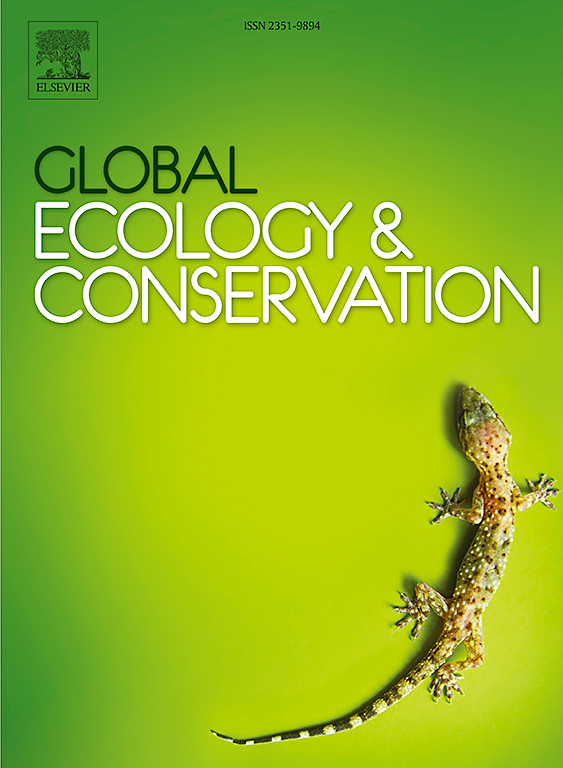Population dynamics and evolutionary history of an endemic Sambucus africana Standl. (Viburnaceae): Evidence from complete plastomes and ecological niche analysis
IF 3.4
2区 环境科学与生态学
Q1 BIODIVERSITY CONSERVATION
引用次数: 0
Abstract
Evolution and demographic history of plant populations are primarily influenced by climatic and geological events. However, evolutionary population dynamics of endemic herbaceous plants in East Africa remains unexplored. In this study, we integrated chloroplast genomes, environmental variables, and geographical distribution datasets to assess the evolutionary relationships and population dynamics of Sambucus africana Standl., an endemic medicinal herb in East African highlands. The findings showed that S. africana genomes exhibited typical quadripartite structures and contained 129 unique genes, including 88 protein-coding, 33 tRNAs, and 8 rRNAs. Population genomics revealed significant degree of intraspecific variations within isolated African-limit populations. The phylogenetic relationship of Dipsacales yielded significantly supported topologies (ML ≥ 83, BI ≥ 0.4) which strongly supported the monophyly of Sambucus. Major lineages of Viburnaceae were estimated to have diverged from the Late Cretaceous 80.89 Mya (95 % PHD = 68.90–91.99 Mya), while within-genus diversification was dated to Eocene and later. Ancestral area reconstruction revealed that the most probable ancestral area for Sambucus is Asia, with a secondary ancestral presence in North America, followed by diversification to other regions. Species distribution modeling indicated that under Shared Socio-Economic Pathway 585 (SSP585), the potentially suitable habitats for S. africana would significantly decline around Mt. Elgon parts of Uganda (western) and Kenya (central parts of Mt. Kenya) and southwestern parts of Ngorongoro conservation area relative to SSP126. Therefore, conservation units of western and eastern Mt. Elgon groups in Uganda, among other distributional regions in Kenya and Tanzania should be established for this endemic medicinal herb.
特有非洲树苗的种群动态和进化历史。(Viburnaceae):来自完整质体体和生态位分析的证据
植物种群的进化和人口历史主要受气候和地质事件的影响。然而,东非特有草本植物的进化种群动态仍未被探索。在本研究中,我们整合了叶绿体基因组、环境变量和地理分布数据集来评估非洲Sambucus africana Standl的进化关系和种群动态。东非高地的一种地方性草药。结果表明,非洲南方南方种基因组具有典型的四部结构,包含129个独特基因,其中包括88个蛋白质编码基因、33个trna和8个rrna。种群基因组学揭示了在孤立的非洲限制种群中显著程度的种内变异。Dipsacales的系统发育关系得到了显著支持的拓扑结构(ML≥83,BI≥0.4),这有力地支持了Sambucus的单系性。维本科的主要谱系从晚白垩世80.89 Mya(95 % PHD = 68.90-91.99 Mya)开始分化,而属内分化则发生在始新世及以后。祖先区域重建显示,sambuus最有可能的祖先区域是亚洲,其次是北美,然后是其他地区。物种分布模型表明,在共享社会经济路径585 (SSP585)下,乌干达埃尔贡山部分地区(西部)和肯尼亚中部地区(中部)以及恩戈罗恩戈罗保护区西南部地区的潜在适宜生境相对于SSP126将显著减少。因此,除了在肯尼亚和坦桑尼亚的其他分布地区外,还应在乌干达的埃尔贡山西部和东部类群建立保护单位。
本文章由计算机程序翻译,如有差异,请以英文原文为准。
求助全文
约1分钟内获得全文
求助全文
来源期刊

Global Ecology and Conservation
Agricultural and Biological Sciences-Ecology, Evolution, Behavior and Systematics
CiteScore
8.10
自引率
5.00%
发文量
346
审稿时长
83 days
期刊介绍:
Global Ecology and Conservation is a peer-reviewed, open-access journal covering all sub-disciplines of ecological and conservation science: from theory to practice, from molecules to ecosystems, from regional to global. The fields covered include: organismal, population, community, and ecosystem ecology; physiological, evolutionary, and behavioral ecology; and conservation science.
 求助内容:
求助内容: 应助结果提醒方式:
应助结果提醒方式:


